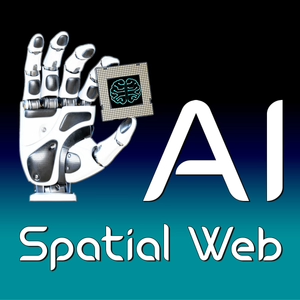
Spatial Web AI Podcast
Denise Holt
1 Listener
All episodes
Best episodes
Seasons
Top 10 Spatial Web AI Podcast Episodes
Goodpods has curated a list of the 10 best Spatial Web AI Podcast episodes, ranked by the number of listens and likes each episode have garnered from our listeners. If you are listening to Spatial Web AI Podcast for the first time, there's no better place to start than with one of these standout episodes. If you are a fan of the show, vote for your favorite Spatial Web AI Podcast episode by adding your comments to the episode page.
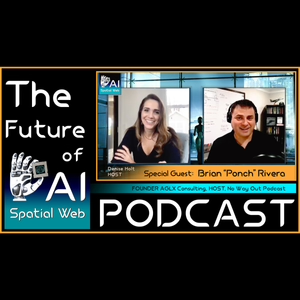
Episode 4 | Special Guest - Brian Ponch Rivera - Founder AGLX Consulting | Spatial Web AI Podcast
Spatial Web AI Podcast
07/21/23 • 55 min
NEW EPISODE: Special Guest - Brian "Ponch" Rivera - Founder, AGLX Consulting, Creator of The Flow System, and Co-Host of the No Way Out Podcast
What is Active Inference AI? What is the Free Energy Principle (FEP)? And what do they have to do with agility, corporate leadership, and The Flow System? – Find out in this episode of the Spatial Web AI Podcast by Denise Holt.
A former navy pilot, Brian discusses his work in the agile community. He explains that he started a consulting firm, AGLX, to improve Scrum and Agile practices. He also introduces his concept of the Flow System, which focuses on team interactions and is influenced by complexity theory and distributed leadership. Brian talks about his TED Talk in Budapest on design for flow and mentions the loss of Mihaly Csikszentmihalyi, who coined the idea of flow from psychological flow. He describes how AGLX has expanded its focus beyond Agile and Scrum to include topics such as safety, innovation, artificial intelligence, psychedelic therapy, and fifth-generation warfare. Brian also discusses his podcast, No Way Out, centered around John Boyd's work on the OODA Loop and attracting guests from various disciplines. Denise asks Brian about the flow system's development and its connection to complex adaptive systems thinking. They talk about how interactions matter more than frameworks in creating agility within organizations. Brian emphasizes understanding one's external environment to develop effective strategies through an internal model or map. This aligns with concepts like active inference principles discussed in recent readings related to AI, autism research, psychedelics research, category theory, etc., which have connections with Boyd's OODA Loop framework.
● Brian discusses the creation of the Flow System and its purpose
● They talk about the importance of context in understanding
● Active Inference and Cognitive Task Analysis
● A. Brian explains the concept of active inference
● B. He discusses cognitive task analysis and how it helps in understanding
● Brian emphasizes the need for individuals to develop an internal map of their external world.
● They discuss the role of large language models and the need for active engagement.
● Brian talks about the importance of effective debriefing and creating psychological safety.
● They discuss the process of synthesizing and analyzing new information.
● Brian mentions the importance of language and stories in shaping our perception of the world.
● Brian shares a simple reading exercise to highlight the importance of context.
● They discuss the challenge of getting the attention of leaders in organizations.
● Brian mentions the use of active inference AI and rapid feedback in technical skills training.
● They talk about the benefits of using large language models for learning.
● Brian mentions the concept of cognitive warfare.
● They discuss the importance of keeping context rich with data without interpretation.
● Brian emphasizes the importance of finding new information that changes the way we view the world.
● Brian emphasizes the importance of learning about what makes us human
Special thank you to Brian, for being on our show!
You can learn more about The Flow System, AGLX Consulting, and the No Way Out Podcast on their website here.
Check out our other Episodes and watch all the videos in the Knowledge Bank Playlist to learn more about the Spatial Web and Active Inference AI.
You can also learn more on my blog: https://deniseholt.us
#activeinferenceai #spatialcomputing #artificialintelligence #spatialweb #aigovernance
1 Listener

VERSES AI Compared with Open AI According to ChatGPT4 | KB 14 Spatial Web AI Podcast
Spatial Web AI Podcast
06/20/23 • 18 min
VERSES AI Compared with Open AI According to ChatGPT4 #futureofai #artificialintelligence by Denise Holt
VERSES AI has developed a unique methodology that combines Active Inference AI with the Spatial Web Protocol, trained on real-time data within a common network of Intelligent Agents based on real-world events as they occur and unfold over time.
OpenAI administers a multi-modal methodology of generative Machine Learning AI derived from LLMs trained on text/image pairs.
In a mere three question conversation with ChatGPT4, the OpenAI bot provided a solid basis for understanding the greatest issues facing Machine Learning LLMs, the advantages of Active Inference AI over LLMs, and the way in which the next evolution of the internet protocol, the Spatial Web, when combined with Active Inference AI, can function as a nervous system for a company, city, or even larger systems.
______________________
Special thanks to Dan Mapes, President and Co-Founder, VERSES AI and Director of The Spatial Web Foundation. If you’d like to know more about The Spatial Web, I highly recommend a helpful introductory book written by Dan and his VERSES Co-Founder, Gabriel Rene, titled, “The Spatial Web,” with a dedication “to all future generations.”
Listen to more episodes in my Knowledge Bank Playlist to learn everything you need to know to stay ahead of this rapidly accelerating technology.
Check out more on my blog at https://deniseholt.us
#futureofai
#artificialintelligence
#spatialweb
#activeinference
#ChatGPT4
1 Listener
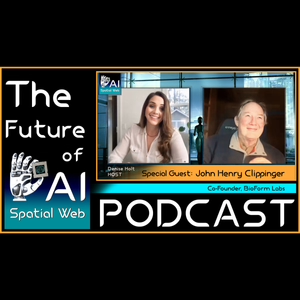
The Shift Toward Natural AI: Dr. John Henry Clippinger on Active Inference & the Future of AI
Spatial Web AI Podcast
03/10/24 • 65 min
Join Spatial Web AI host Denise Holt and Dr. John Henry Clippinger, co-founder of Bioform Labs and research scientist at MIT's Lab City Sciences group, and key figure behind the pivotal letter, "A Natural AI Based on The Science of Computational Physics, Biology and Neuroscience," shares his insights on the future of artificial intelligence. #ActiveInferenceAI #KarlFriston #VERSESAI
Dr. Clippinger discusses the importance of Active Inference, a pioneering approach developed by Dr. Karl Friston, Chief Scientist at VERSES AI, which draws upon computational neuroscience, biology, and physics to create AI systems that exhibit key attributes of living systems. He underscores the crucial need for principled governance in AI to protect privacy and self-sovereignty, advocating for active inference principles and open-source initiatives through the Active Inference Foundation to ensure global AI safety.
Exploring societal impacts, Clippinger champions natural intelligence approaches over traditional Deep Learning models, emphasizing the importance of ethical considerations in human-machine interactions. With a focus on educational initiatives, he envisions a future where these principles drive positive change across fields, including addressing pressing global challenges like climate change, fostering safe AI as a public good and shaping a collaborative, inclusive future.
Tune in for all this and more...
Special thank you to Dr. John Henry Clippinger for being on our show!
Connect with Dr. Clippinger:
LinkedIn: https://www.linkedin.com/in/john-henry-clippinger-5ab1b
Connect with Denise:
Website: https://deniseholt.us/
Join the Spatial Web AI Substack Community: https://deniseholt.substack.com/subscribe
LinkedIn: https://www.linkedin.com/in/deniseholt1
#ActiveInference #NaturalAI
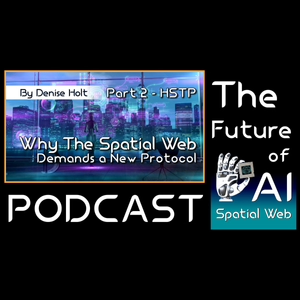
Why the Spatial Web Demands a New Protocol Pt 2 - HSTP | KB #7 Spatial Web AI Podcast
Spatial Web AI Podcast
03/27/23 • 14 min
Why the Spatial Web Demands a New Protocol Part 2 - HSTP #futureofai #artificialintelligence by Denise Holt
The impact of HSTP on the future of ai: Static vs. States of Being
Web pages are static by nature. They were created for users to interact with the individual websites and the information contained within them. Although you may be able to create, interact with, or change elements, content, information, and essentially ‘do things’ within a page, it all remains fixed within that website domain. At best, data can be made ‘shareable’ across platforms through open APIs, but the data remains fixed at the domain endpoints.Web 3.0 requires something very different.
The networked convergence of emerging technologies like augmented reality, virtual reality, and artificial intelligence, coupled with distributed ledger technology and virtual spaces (metaverse or digital twin), while throwing the internet of things (IOT) with trillions of data collecting sensors into the mix, generates many additional data points and conditions that need to be accounted for in a true AR (augmented reality) existence. Undertaking this task of connecting every person, place, or thing, both real and virtual, while also considering states of being, conditions, and permissions (access, privacy, security, ownership), with continual updates in real time, well, this takes a completely new way of thinking, in order to connect and process such an enormous amount of information occurring within and between all objects, circumstances, and people.
The Smart Technologies of Web 3.0, like Smart Spaces, Smart Assets, Smart Contracts, Smart IDs, Smart Accounts, and Smart Payments, are only part of the picture of the augmented world we all envision for the future we are embarking upon. Without interoperability in real-time, these are all siloed technologies with limited range and scope of use. An inclusive interface is necessary to join these Smart Technologies, along with humans, machines, content, data, assets, locations, buildings, factories, workflows, imagination, and the context of real-time interaction across every one of them, embracing and including previous Web 2.0 technologies and cloud databases.
THIS is the Web 3.0 of the future. THIS will become the Internet of Everything.
Enter HSTP (Hyperspace Transaction Protocol)
Beyond 'location' to include 'states of being.'
Read the full article on the Spatial Web AI blog:
______________________
Special thanks to Dan Mapes, President and Co-Founder, VERSES AI and Director of The Spatial Web Foundation. If you’d like to know more about The Spatial Web, I highly recommend a helpful introductory book written by Dan and his VERSES Co-Founder, Gabriel Rene, titled, “The Spatial Web,” with a dedication “to all future generations.”
Listen to more episodes in my Knowledge Bank Playlist to learn everything you need to know to stay ahead of this rapidly accelerating technology.
Check out more at, SpatialWebAI and Spatial Web Foundation
#futureofai #artificialintelligence #spatialweb #intelligentagents #aitools
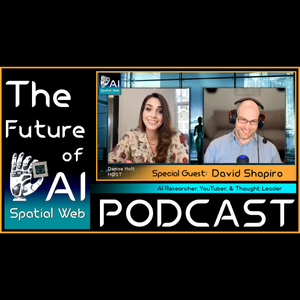
Episode 5 | Guest: David Shapiro - AI Researcher | Talking AI Benefits, Dangers, & AI Governance
Spatial Web AI Podcast
08/08/23 • 73 min
NEW EPISODE: Host, Denise Holt, welcomes David Shapiro, an AI researcher and thought leader, as the special guest on this episode of the Spatial Web AI podcast. In this broad range conversation, Dave discusses the polarizing views on AI, acknowledging both its potential benefits and dangers. He emphasizes the need for careful deployment and solving problems that arise with new technologies. David also touches upon existential questions raised by creating super intelligent AI. He believes that while there may be a painful transition period, society has historically adapted to technological changes. The biggest challenges he sees in transitioning to AGI and ASI are organization and communication due to rapid advancements in AI. Additionally, he discusses how technology will change job markets and introduces the concept of post-labor economics where people will need to find new meaning outside of work. The conversation also explores how spatial web technologies could enhance accountability and prevention in various domains such as construction site safety or highway incidents involving unsecured cargo on trucks. Special thank you to Dave , for being on our show! Connect with David Shapiro on LinkedIn for consulting, speaking, training, or collaboration opportunities. https://www.linkedin.com/in/dave-shap-automator Include a note when connecting on LinkedIn to provide context and purpose. Consider joining Dave's Patreon for further engagement and access to his content. https://www.patreon.com/daveshap Check out our other Episodes and watch all the videos in the Knowledge Bank Playlist to learn more about the Spatial Web and Active Inference AI. You can also learn more on my blog: https://deniseholt.us #activeinferenceai #AGI #ASI #artificialintelligence #spatialweb #aigovernance
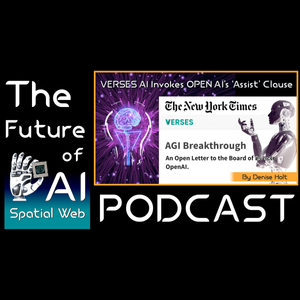
VERSES AI Announces AGI Breakthrough | Invokes Open AI's 'Assist' Clause
Spatial Web AI Podcast
01/15/24 • 22 min
Audio Narration of the article, VERSES AI Announces AGI Breakthrough | Invokes Open AI's 'Assist' Clause by Denise Holt, Spatial Web AI Podcast #AGI #ActiveInference #VERSESAI
VERSES has achieved an AGI breakthrough within their alternative path to AGI called Active Inference. And on December 20, 2023, they appealed to Open AI “in the spirit of cooperation and in accordance with [their} charter,” by taking out a full page ad in the New York TImes with an Open Letter to the Board of Driectors at Open AI.
🔍 Key Points: 🧠💡
• VERSES New Path to AGI: Focusing on 'natural' rather than 'artificial' intelligence.
• Active Inference Breakthrough: A significant advancement that challenges traditional AI models.
• A Gesture in the Spirit of Cooperation: Aligning with Open AI's mission for safe AGI that benefits humanity.
• Challenges of Deep Learning: Addressing the limitations and dangers of current AI approaches.
• VERSES vs DeepMind: A contrast between the approaches of Geoffrey Hinton and Karl Friston.
• The Free Energy Principle: Unlocking a new direction in AI, grounded in natural intelligence.
• AGI Roadmap: Detailed stages from Systemic to Shared Intelligence, leading to potential super-intelligence.
• Collaboration Call: A significant appeal for cooperation within the AI community.
🧠 Why It Matters:
This announcement is more than just a technological advancement; it's a call for a paradigm shift in how we approach AGI. VERSES AI is inviting us to reconsider our relationship with technology, emphasizing cooperation, safety, and alignment with human values. Explore the future of AI with Active Inference and gain insights into this revolutionary approach!
Visit my blog and Subscribe to my channels:
Spatial Web AI website: https://deniseholt.us
Substack: https://deniseholt.substack.com
LinkedIn: https://spatial-web-ai-6985009124036030464
#VERSESAI #AGI #OpenAI #ActiveInference #KarlFriston #IntelligentAgents #FirstPrinciples #FutureOfAI
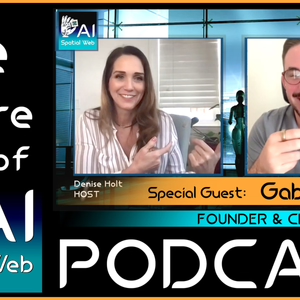
Episode 1 | Special Guest: Gabriel Rene CEO VERSES AI | Spatial Web AI Podcast
Spatial Web AI Podcast
03/25/23 • 67 min
Special Guest: Gabriel Rene – CEO and Founder, VERSES AI #futureofai #artificialintelligence by Denise Holt
In this episode, I had the pleasure of sitting down with Gabriel Rene, CEO and Co-Founder of VERSES AI, Executive Director of the Spatial Web Foundation, and Chairman of the IEEE Working Group for the Spatial Web Protocol.
Join us as we discuss his background, what led him on this journey to co-found one of the most important companies in AI technology and the next evolution of the internet.
Topics covered:
· What is the Spatial Web vs. WWW?
· The new internet protocols, HSTP & HSML
· The Spatial Web and Augmented Reality through Active Inference AI, HSTP & HSML, and KOSM OS TM
· What are Spatial Domains?
· What is Active Inference AI?
· Intelligent Agents vs Machine Learning AI
· The inherent security baked into the Spatial Web
· Issues with ChatGPT4
· And More!
Special thanks to Gabriel Rene, for being on our show!
If you’d like to know more about The Spatial Web, I highly recommend a helpful introductory book written by Gabriel and his VERSES Co-Founder, Dan Mapes, titled, “The Spatial Web,” with a dedication “to all future generations.”
Check out our other Episodes and watch all of our videos in the Knowledge Bank Playlist to learn everything you need to know to stay ahead of this rapidly accelerating technology.
Check out more at, SpatialWebAI
#futureofai
#artificialintelligence
#spatialweb
#intelligentagents
#aitools
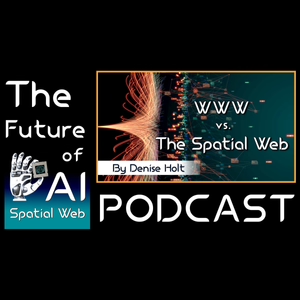
WWW vs The Spatial Web | KB #5 Spatial Web AI Podcast
Spatial Web AI Podcast
03/24/23 • 7 min
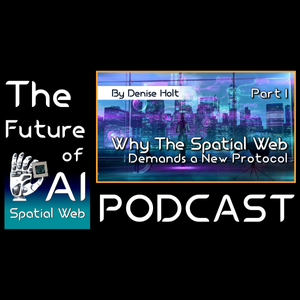
Why the Spatial Web Demands a New Protocol Part 1 | KB #6 Spatial Web AI Podcast
Spatial Web AI Podcast
03/26/23 • 11 min
Why the Spatial Web Demands a New Protocol Part #futureofai #artificialintelligence by Denise Holt Before we go deep diving into the new Spatial Web Protocols, HSTP and HSML, it is important to understand what brought us to this point. As technology evolves, the way in which we interact with it and utilize it to enhance our daily lives and productivity naturally demands more expansion and sophistication over time. As humans, we are naturally curious beings, always pushing boundaries to new heights of discovery. This basic factor, coupled with Ray Kurweil’s Law of Accelerating Returns, sets forth the evolution of information technologies on a predictable and exponential trajectory of growth, creating an increasingly more complex interrelationship and interdependency with our way of life. ........ Trillions of IOT sensors are coming online in these next ten years with data points that AI will interact with to update digital twin environments in real time. Over time, AI “assistants” will become the dominant user of the Spatial Web, parsing the gargantuan amount of data and information for us to access, use, and navigate through our daily lives. You can read this full article on my blog Spatial Web AI ______________________ Special thanks to Dan Mapes, President and Co-Founder, VERSES AI and Director of The Spatial Web Foundation. If you’d like to know more about The Spatial Web, I highly recommend a helpful introductory book written by Dan and his VERSES Co-Founder, Gabriel Rene, titled, “The Spatial Web,” with a dedication “to all future generations.” Listen to more episodes in my Knowledge Bank Playlist to learn everything you need to know to stay ahead of this rapidly accelerating technology. Check out more at, SpatialWebAI and Spatial Web Foundation #futureofai #artificialintelligence #spatialweb #intelligentagents #aitools
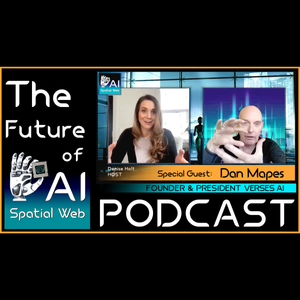
Episode 2 | Special Guest Dan Mapes – Founder, VERSES AI | Spatial Web AI Podcast
Spatial Web AI Podcast
03/31/23 • 77 min
Special Guest: Dan Mapes, President and Founder, VERSES AI #futureofai #artificialintelligence by Denise Holt
In this episode, I had the pleasure of sitting down with Dan Mapes of VERSES AI and Director of the Spatial Web Foundation.
Join us as we discuss what’s coming this year with VERSES AI, arguably the most important company in AI technology and the next evolution of the Internet of Everything.
Excerpt: [Dan]:
“There's kind of a humorous cartoon that goes around in the AI circles, and it's like, AGI is the Moon, artificial general intelligence, human intelligence. And artificial narrow intelligence is being here on the ground looking up at the Moon. And the thing is, how do we get to the Moon? And so artificial narrow intelligence is climbing like the Eiffel Tower or the Empire State Building. They've gone up ten floors. They go, see, we're closer. Then they go up 20 floors, see we're closer, 30 floors, see, we're closer. And so that's why a lot of people think, well, you can't get to the Moon that way because you're just training neurons, and you've got to get bigger and bigger and more expensive and more flaws. So that will not get you to an Artificial General intelligence, even though most people think it will. But a lot of high end artificial intelligence specialists do not believe that's a good path. And so a better path, rather than climbing a building to get to the Moon, would be to build a rocket. Well, that means you got to start over a whole entire new approach. You're not just getting from the 10th floor to the 20th floor in the building. You're going like, we're not even using the building. We're going to go over here and build this new kind of thing, kind of like a building. It's tall and thin, but it's got a big engine on the thing on it, and you can get to the Moon with this thing. And so that's called artificial General Intelligence tools. And what we've done is we've partnered with a brilliant neuroscientist in England who's been working on a new theory of AI called active inference AI, based on the free energy principle. And the work that we're doing and the work that he and his research staff and PhDs were working on just merges together so perfectly and beautifully. So then the synergy out of, it's not ten plus ten. It's ten times ten. Right. So they got their stuff that far, we got our stuff this far. We put them together, and then, like, it just goes. So that's the magic that's taking place at Verses AI right now is this extraordinary research that's been going on at the University College of London under the direction of Dr. Karl Friston. And then our teams work in traditional artificial narrow intelligence and using that in this new architectural stack of interfaces, logics, and data frameworks. And we brought that all together with these spatial web protocols. Wow, that's it. Now we can give anybody the ability to create AI applications anywhere in the world and at any age, and so we're going to gather the collective wisdom of humanity and then link it all together. And then AI is then a larger meta AI and has access to all of that to help us manage the planet as an example.”
Listen to the full episode for more.
Special thanks to Dan Mapes, for being on our show!
If you’d like to know more about The Spatial Web, I highly recommend a helpful introductory book written by Danl and his VERSES Co-Founder, Gabriel Rene, titled, “The Spatial Web,” with a dedication “to all future generations.”
Check out our other Episodes and watch all the videos in the Knowledge Bank Playlist to learn everything you need to know to stay ahead of this rapidly accelerating technology.
Check out more at, SpatialWebAI
#futureofai
#artificialintelligence
#spatialweb
#intelligentagents
#aitools
Show more best episodes

Show more best episodes
FAQ
How many episodes does Spatial Web AI Podcast have?
Spatial Web AI Podcast currently has 38 episodes available.
What topics does Spatial Web AI Podcast cover?
The podcast is about Podcasts and Technology.
What is the most popular episode on Spatial Web AI Podcast?
The episode title 'VERSES AI Compared with Open AI According to ChatGPT4 | KB 14 Spatial Web AI Podcast' is the most popular.
What is the average episode length on Spatial Web AI Podcast?
The average episode length on Spatial Web AI Podcast is 36 minutes.
How often are episodes of Spatial Web AI Podcast released?
Episodes of Spatial Web AI Podcast are typically released every 3 days, 17 hours.
When was the first episode of Spatial Web AI Podcast?
The first episode of Spatial Web AI Podcast was released on Mar 21, 2023.
Show more FAQ

Show more FAQ